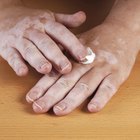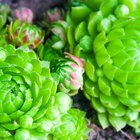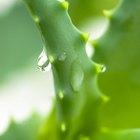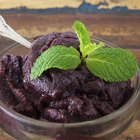Scabies is a skin disease caused by the parasitic mite Sarcoptes scabiei. The mite burrows under the skin and lays its eggs, causing an allergic reaction that results in intense itching. Scratching may lead to a staphylococcus or streptococcus infection or to a severe form of scabies known as crusted scabies, according to the Mayo Clinic. Conventional treatment may involve permethrin, lindane or ivermectin, but these are neurotoxins and may have serious side effects, and the mite is becoming resistant to some of them. Herbs are a natural way to treat scabies safely and effectively. But it is important to consult a health-care professional before starting herbal treatment.
Tea Tree
The tea tree, or Melaleuca alternifolia, is a small tree native to Australia. Traditionally, aboriginal groups used the tea tree as an antiseptic and to treat bruises, insect bites and skin infections. The essential oil is rich in terpenoids, especially terpinen-4-ol, with potent antibacterial and antifungal properties. Tea tree oil is effective against Staphylococcus aureus, the bacteria responsible for secondary infections in people with untreated scabies. A study published in the May 2004 issue of the Archives of Dermatology compared tea tree oil to permethrin and ivermectin on mites taken from a woman with encrusted scabies. The study found that after one hour, 85 percent of the mites treated with terpinen-4-ol from tea tree were dead, while only 5 percent of mites treated with permethrin and ivermectin were dead. This small study demonstrates the potency of tea tree oil, but larger clinical trials are needed to confirm this finding.
Aloe
Aloe, or Aloe vera, is a succulent plant that originated in North Africa but is found in arid climates around the world. It is one of the oldest herbal remedies and was used by the ancient Egyptians, Greeks and Romans. Aloe contains anthraquinones, polyphenols, rhein, p-coumaric acid, lupeol and cinnamic acid, which have anti-microbial and anti-pesticide properties. The gel is used to heal wounds, skin disorders, insect bites and acne. A study published in the October 2009 issue of Phytotherapy Research compared aloe gel to benzyl benzoate, a conventional treatment for scabies. The study found that aloe was as effective as the conventional drug and did not cause any side effects. Larger studies are needed, however, to confirm these findings and to determine the active anti-mite ingredient in aloe.
Balsam of Peru
Balsam of Peru, or Myroxylon pereirae, is a tall evergreen native to South and Central America. The balsam, an aromatic oily resin from the bark, is used in herbal medicine and to make perfumes. The resin contains cinnamein, benzyl benzoate, cinnamic acid, farnesol and nerolidol, which have anti-parasitic and antibacterial properties. European herbalists use the balsam to treat bacterial and fungal infections, lice, scabies and skin ulcers. Botanical.com says that balsam of Peru destroys the mite and its eggs. In their book, “Medicinal Plants of the World,” Ben-Erik Van Wyk and Michael Wink state that the benzyl benzoate in the balsam works against skin parasites, especially scabies. Studies are needed, however, to scientifically validate the traditional uses of this balsam.
Related Articles

What Are the Benefits of Extrapone ...

Black Pepper Oil for Vitiligo

What Is Aloe Good For?

Chasteberry for Acne

Chamomile & Aloe Skin Care

Arnica for Acne

Eucalyptus Oil & Acne

Recommended Daily Dosage of Saw ...

The Best Vitamins for Sinuses

Plants That Heal Wounds

Burdock Root for Acne

What Foods Provide Calcium D-Glucarate?

Herbs For Melasma

Zinc Treatment for Rosacea

Aloe Ferox Benefits

What Does Kigelia Fruit Extract Do for ...

Bromelain & Bruising

Snail Cream Benefits

Acai Berry & Acne

Fraxel Laser Treatment Dangers
References
- Mayo Clinic
- “Archives of Dermatology”; Acaricidal activity of Melaleuca alternifolia (tea tree) oil: in vitro sensitivity of sarcoptes scabiei var hominis to terpinen-4-ol; Walton SF, McKinnon M, Pizzutto S, Dougall A, Williams E, Currie BJ; May 2004
- “Phytotherapy Research”; Preliminary study of effectiveness of aloe vera in scabies treatment; Oyelami OA, Onayemi A, Oyedeji OA, Adeyemi LA; October 2009
- Botanical.com
- “Medicinal Plants of the World”; Ben-Erik van Wyk and Michael Wink; 2009
Writer Bio
Janet Contursi has been a writer and editor for more than 23 years. She has written for professional journals and newspapers, and has experience editing educational, cultural, and business articles and books. Her clients include Gale Publishers, Anaxos, Vielife and Twin Cities Wellness. Contursi earned her Ph.D. at the University of Minnesota, where she studied cultural anthropology, South Asian languages and culture, and art history.